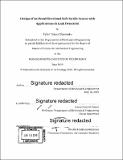Design of an omnidirectional soft tactile sensor with applications in leak detection
Author(s)
Okamoto, Tyler Takeo.
Download1201692531-MIT.pdf (15.13Mb)
Other Contributors
Massachusetts Institute of Technology. Department of Mechanical Engineering.
Advisor
Kamal Youcef-Toumi.
Terms of use
Metadata
Show full item recordAbstract
Soft robots have many unique geometries requiring different tactile feedback mechanisms. In order to respond to their environment, soft robots would benefit by having multi-axis sensors that can determine how a surface is being contacted. As a particular application, previous soft sensor designs are used to detect leaks in active water pipes, but have difficulty differentiating leaks from pipe joints and obstacles. This thesis presents the design, fabrication and experimental testing of soft, multi axis deformation sensors. In the first approach, various geometries of a piezoresistive rubber sensor were tested, and the soft-bodied drone for mapping the interior of pipes was demonstrated in a field test conducted in Matio, Brazil. This demo yielded some design realizations, which led to changes in the sensing technology in order to provide more detail about the interior pipe features. Thus, highly flexible conductive fabric and silicone capacitors were investigated as the capacitance sensing element, which exhibits linearity, faster response time, and less hysteresis. Multiple copies of this sensor were arranged in a particular way to decouple the four deformation modes of the material: uniaxial tension, bending, compressive pressure, and torsion. Furthermore, this sensor is well-suited for the detection of leaks, obstacles, and pipe joints in active water pipes.
Description
Thesis: S.M., Massachusetts Institute of Technology, Department of Mechanical Engineering, June, 2019 Cataloged from PDF version of thesis. Includes bibliographical references (pages 97-100).
Date issued
2019Department
Massachusetts Institute of Technology. Department of Mechanical EngineeringPublisher
Massachusetts Institute of Technology
Keywords
Mechanical Engineering.